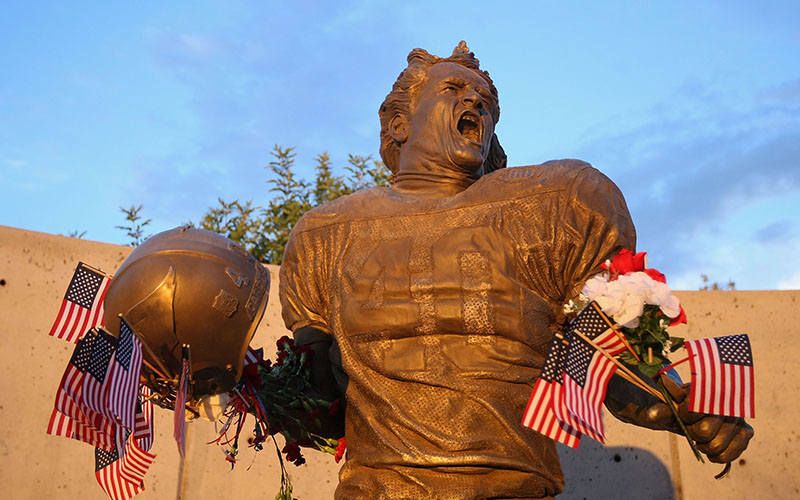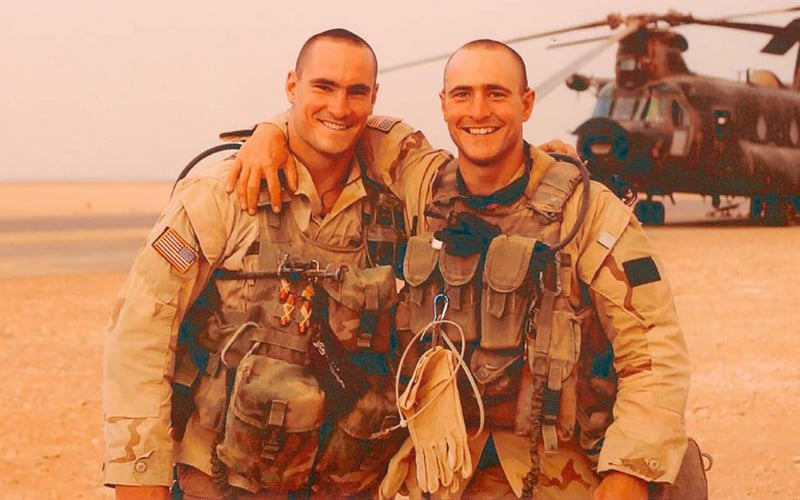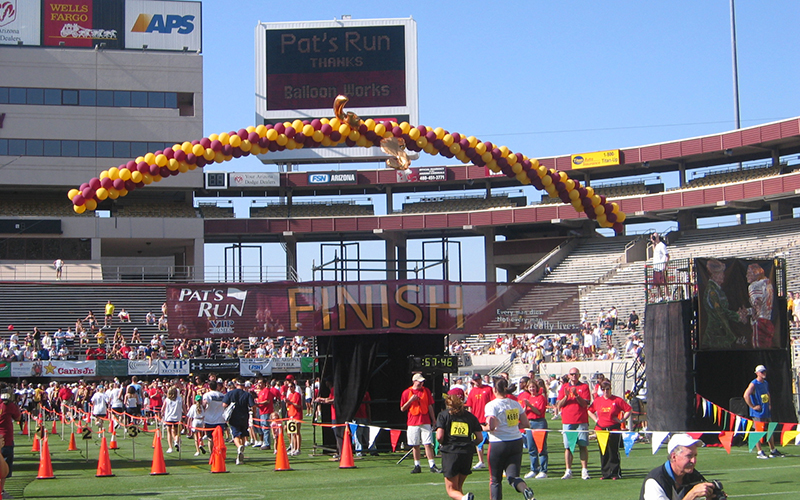With the sports world on hold, Cronkite News will take a daily look at this day in sports history and reflect on some of the biggest moments in Arizona sports.
TEMPE – In the culmination of the NFL’s marketing campaign to celebrate the league’s 100th anniversary, a spot aired during Fox’s broadcast of Super Bowl LIV that showed a young boy running with a football across the country, interacting with current and past NFL stars, eventually finishing his journey at Miami’s Hard Rock Stadium.
Along the way, he stops outside State Farm Stadium in Glendale, looks up at the statue of former Arizona State and Cardinals defender Pat Tillman and pauses momentarily to reflect before continuing his journey.

It is how many Americans, and especially those in Arizona, pause on this day each year to remember Tillman, who in the wake of the September 11, 2001, terrorist attacks, decided to walk away from a multimillion dollar contract from the Cardinals to join the elite U.S. Army Rangers.
Tillman was killed by friendly fire on April 22, 2004, while serving in Afghanistan.
Some criticized the commercial, arguing that it exploited Tillman’s memory. Not Jeremy Staat, Tillman’s former ASU teammate who went on to an NFL career before, inspired by Tillman, he joined the U.S. Marine Corps.
“I thought it was great that they’re bringing the veterans, and paying tribute to all veterans,” Staat said. “Pat was just one of millions, and I think it was great that he can be an icon to bring remembrance to all veterans, because at the end of the day, that’s what Pat would want.”
Tillman’s name has become synonymous with words like “courage” and “selflessness,” not only within the Arizona community, but across the country. He made his name in football, but not his legacy.
Tillman joined the ASU defense as a linebacker, defensive back and special teams player under coach Bruce Snyder in 1994.
The Sun Devils had their best season during Tillman’s years in Tempe in 1996. He was the team’s second-leading tackler as a junior that season and earned second team All-Pac-10 honors.
More importantly, the Sun Devils finished the regular season 11-0, ranked No. 2 in the country and with a shot at a national championship if they could beat fourth-ranked Ohio State in the Rose Bowl. The Sun Devils took a late lead in that game on quarterback Jake Plummer’s iconic scramble and dive into the end zone, but ultimately fell, 20-17.
“If you were to just take his career and stop it after all the other things that have happened since, you’d remember a Pac-10 (Defensive) Player of the Year, a guy who helped take us to the Rose Bowl, and a guy who played with an unbelievable amount of passion,” said Doug Tammaro, assistant athletic director in media relations at ASU “One of the greatest student-athletes we’ve ever had.”
Tillman finished his ASU career in 1997, taking home second-team All-America honors and that Pac-10 Defensive Player of the Year award. ASU reached consecutive bowl games for the first time in 10 years and beat Iowa, 17-7, in the 1998 Sun Bowl in Tillman’s final game as a Sun Devil.
But the Cardinals kept Tillman in Arizona, selecting him in the seventh round of the NFL Draft, 226th overall, believing he could transition from linebacker at ASU to safety in the NFL. And they were right.
“You rarely get to play in the same hometown that you play college in, in the pros,” Tammaro said. “Cardinals fans are going to remember him for just being an outstanding player who was a seventh-round pick. So there’s the underdog story, as well.”
He became a dependable component in Arizona’s secondary, appearing in all 48 games over his first three seasons and in 12 games during 2001.

The Pat Tillman statue at State Farm Stadium was featured in a recent Super Bowl commercial that has drawn mixed opinions about its use. (Photo by Christian Petersen/Getty Images)
That is when Tillman’s life and legacy took a dramatic turn. The terrorist attacks on the World Trade Center and the Pentagon on 9-11 caused Tillman to take his own pause for reflection.
He famously told reporters that many in his family had served, and “I really haven’t done a damn thing.”
He decided against signing a three-year, $3.6 million contract extension offered by the Cardinals and quietly enlisted in May of 2002.
“When he said he’s joining the military, I just remember taking a deep breath and thinking to myself, ‘Yeah, of course he is. That makes total sense. That’s what the military needs right now,'” Tammaro said. “That’s the type of thing that Pat would do.”
It made sense because those who knew Tillman best, like Tammaro and Staat, remember him as a thoughtful person who put the needs of others above his own. It wasn’t all about football with Tillman. His decision to leave the NFL to serve encapsulated who he was. He entered the Army with no fanfare, and he refused interview requests because he didn’t want to be treated differently than others who signed up.
“He got to know people on a personal level,” Staat said. “He wasn’t much of a showboat, and he wasn’t trying to act like he was better than anyone. He wanted to know what made people click. He was always about the team, and he was always about the other guy.”
There was disbelief and heartbreak in Arizona when the news broke that Tillman had been killed while on patrol in eastern Afghanistan. Initially, the Army said that he had been shot when his patrol was ambushed by enemy fighters, but Tillman’s family soon learned that he had been killed by friendly fire. He was 27.
Tammaro recalled the coming weeks and months after the news as one of the hardest times in Arizona State history. Makeshift memorials were set up outside Sun Devil Stadium and the Cardinals’ practice facility, where people left notes and flowers. There were even boots at the makeshift memorials, left behind by other veterans.
Soon after his death, Perry Edinger, who was the head athletic trainer at ASU when Tillman played there, Tillman’s brother-in-law Alex Garwood and Tammaro began putting together plans for an event to honor and remember Tillman.
Pat’s Run, an annual 4.2 mile run that begins near Sun Devil Stadium and ends on the 42-yard-line – reflecting the No. 42 jersey Tillman wore – came out of their efforts. It takes place on the Saturday closest to April 22 each year and raises money for the Pat Tillman Foundation.
Edinger, an avid runner, was the event’s first race director. The first Pat’s Run took place in 2005 and it has grown to become the largest timed running event in Arizona. Race organizers eventually capped entries at 38,000 runners or walkers each year.
“Perry told me he thought we could someday get 25,000 runners,” Tammaro said. “I laughed, and I said ‘No way.’ The first race, I think we had 3,000 or 5,000, and it just kept building and building.”
Like that Super Bowl commercial, one of the most meaningful memories for Tammaro also came from a child, delivered during the memorial service held at Sun Devil Stadium for Tillman.
“I remember one little kid wrote a note,” Tammaro said. “He wrote a card that said, ‘Pat, I know you didn’t want to be a hero, but too bad. You are now.'”


